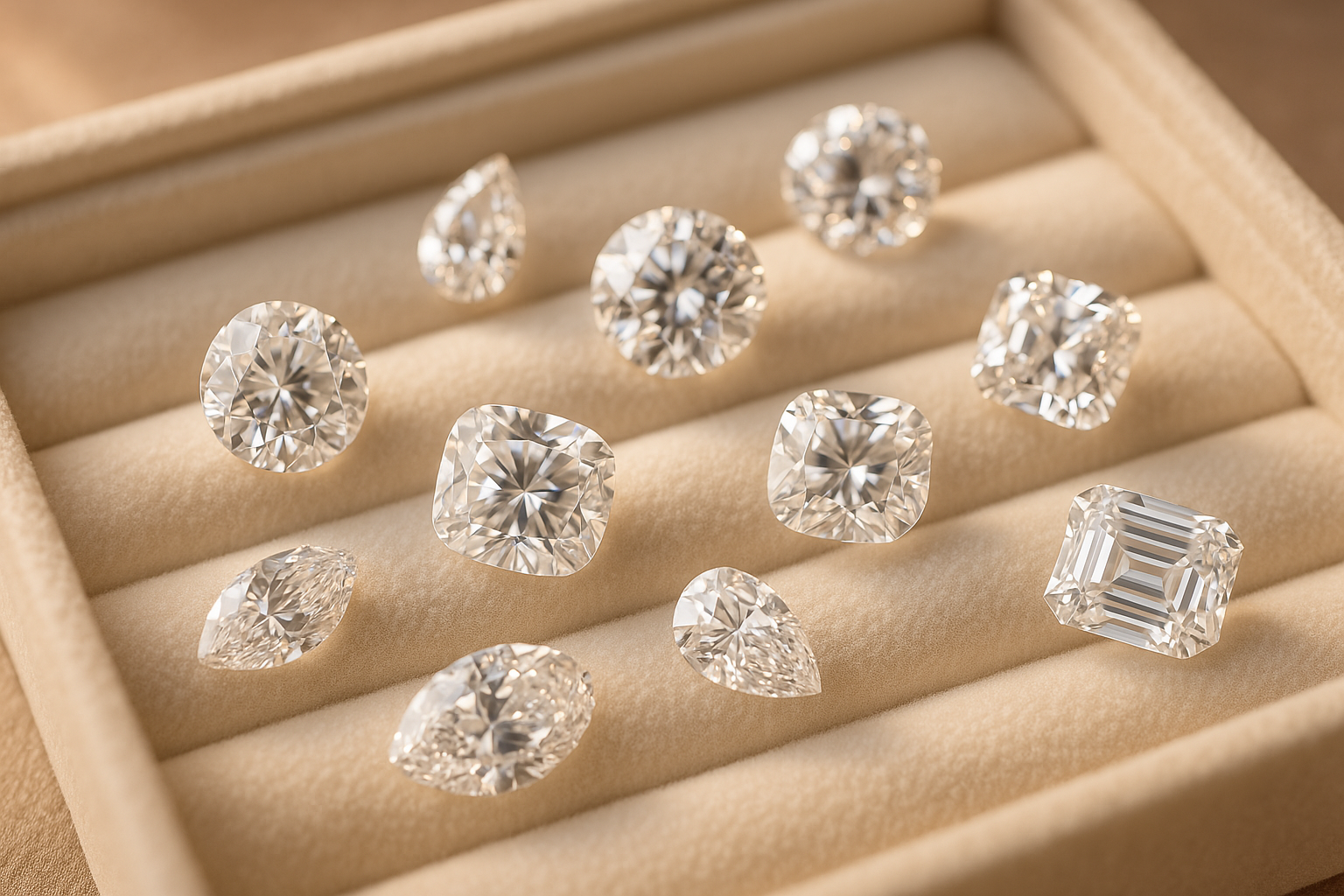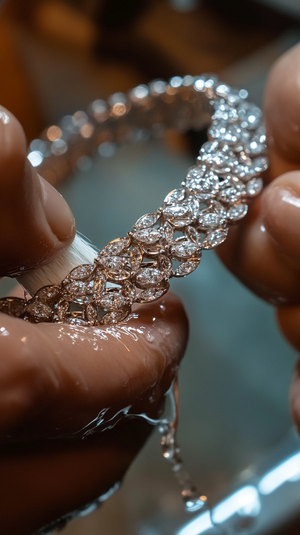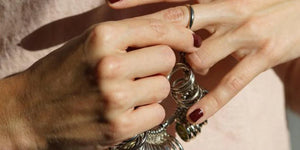Introduction
The best fake diamonds, like cubic zirconia, moissanite, and white sapphire, resemble natural diamonds, and this trend is becoming increasingly popular. These substitutes satisfy various tastes and price points by providing an enticing blend of ethics, affordability, and beauty.
With worries about the morality of conventional diamond mining increasing, synthetic diamonds are becoming a more appealing option. Diamond alternatives save a lot of money and significantly negatively impact the environment.
Due to customer demand for eco-friendly and unique jewelry, ethical and cheap solutions have developed over time. Since diamond alternatives are easily available, buyers can make moral choices without sacrificing beauty or quality.
As consumers seek ethical and affordable luxury, diamond substitutes are transforming the jewelry industry. Let us take you on a stroll through the choices.
Types of Fake Diamonds

Cubic Zirconia (CZ)
Cubic zirconia (CZ) is acclaimed for its striking similarity to diamonds. This artificial gemstone is a popular option for best fake diamond rings since it is affordable, long-lasting, and has a diamond-like appearance.
Colorless clarity similar to a perfect D grade and flawless clarity comparable to an IF or FL grade are typical characteristics of CZ stones, which frequently reveal their artificial nature due to their flawlessness.
Since CZ is less expensive than moissanite and real diamonds, it is increasingly popular as a component of affordable jewelry.
For people who want the elegance of diamonds without the exorbitant price, CZ has become a popular choice because of its inexpensiveness and glamor, which are similar to that of a diamond.
While less expensive than natural diamonds, the best fake diamonds, such as CZ, may not have the same qualities and longevity as their lab-grown or real diamond counterparts, and they may eventually lose their shine.
Moissanite
Moissanite is a highly sought-after fake diamond due to its distinct characteristics. Even though moissanite is almost 10 times more costly than cubic zirconia, its remarkable durability makes it perfect for daily wear.
Moissanite has more fire and brilliance than diamond or CZ because of its higher Refractive Index (RI) of 2.65. Versatile and reasonably priced, moissanite comes in various sizes, shapes, and colors.
Regarding beauty and appeal, moissanites are cheaper than diamonds. This is true whether the stone is more significant, colorless, or a 1-carat blue moissanite with VVS clarity.
Moissanite is a beautiful substitute for diamonds in jewelry like engagement rings, such as the best fake diamond moissanite rings, best fake diamond earrings, and anniversary pendants, providing similar beauty at a lesser price.
Buy Moissanite Loose Stones from Grown Leo
Characteristics of the Best Fake Diamonds
Brilliance and Sparkle
The goal of best fake diamonds is to closely mimic natural diamonds, especially when it comes to brightness and shine.
For example, cubic zirconia resembles actual diamonds but may not have the same clarity and occasionally appear somewhat foggy. Because of its distinct refractive index, moissanite exhibits an alluring "fire" look that adds to its appeal. White sapphires have a similar look but may catch light differently, giving the stone a slight variance in brilliance.
However, these differences are usually undetectable to the untrained eye, thus making these diamond alternatives quite similar to natural diamonds.
Hardness and Durability
When thinking about gemstones as alternatives to diamonds, durability is a crucial factor. Although other options such as moissanite and cubic zirconia have high hardness ratings, they could be slightly more prone to scratches than diamonds.
On the other hand, white sapphires are more prone to damage due to their lower hardness rating.
At the same time, genuine diamonds have a significant durable and hard nature, making them resistant to basic wear & tear. Overall durability is essential when choosing gemstone substitutes, along with balancing cost and long-term worth.
Lab-Grown Diamonds

Introduction to Lab-Grown Diamonds
Since lab-grown diamonds have the same qualities as naturally mined diamonds, they are a present-day marvel in the jewelry industry.
These lab-grown gems are created using Chemical Vapour Deposition (CVD) or High-Pressure, High Temperature (HPHT) techniques, simulating the natural diamond generation process under the earth’s surface.
The conditions are carefully regulated. With a perfect 10 on the Mohs scale, lab-grown diamonds are tough, in contrast to diamond simulants like moissanite and cubic zirconia.
While moissanite and cubic zirconia are not as good at simulating specific optical properties as genuine diamonds, they display the same brightness and glitter.
Furthermore, while natural and lab-grown diamonds have comparable color and clarity grades, imitations such as cubic zirconia are flawless.
In contrast, moissanite usually has an average to high clarity grade. Additionally, cut grade and carat weight are essential criteria for evaluating the quality of lab-grown diamonds.
These artificial gems come in various sizes and cuts, providing customers with a flexible and environmentally friendly substitute for mined diamonds.
Choosing the Right Fake Diamond for You
Consideration of Cut, Color, and Clarity
Selecting the best fake diamond for engagement rings or other jewelry requires careful consideration of cut, color, and clarity.
Cubic zirconia, which resembles diamonds, comes in many forms and sizes allowing for versatile jewelry designs. They are mostly flawless thus you can select one based on size and price.
Moissanite, noted for its brilliance and fire, is an enticing alternative for gem hunters. Not all moissanite have high clarity and complete transparency. But most of the moissanite stones shine bright. Due to which it is recommended to buy moissanite which has a color grade between D-F and clarity grade from FL-VS1.
Lab-grown synthetic diamonds have the beauty and physical qualities of natural diamonds at a reduced cost. It is recommended to make a purchase of a lab-grown diamond which has an ideal cut, D-H color grade and FL-VS2 clarity grade.
Basically examine the stone's cut, clarity, and color. A correct cut shines the stone, clarity minimizes impurities, and color grade determines its hue.
Prioritizing these aspects lets you locate the best fake diamond jewelry for your style and taste.
Setting and Metal Options
Consider certain aspects before choosing the correct settings and metal band for your best fake diamond jewelry.
The initial consideration is the choice of metal. Choose high-quality metals like gold or platinum to improve the piece's look and durability. These metals have a nice feel, they maintain their shape and are rust-resistant.
Also, adjusting settings can make things simpler and easier to customize. Setting the fake diamond beautifully while offering stability and security is vital. Prong, bezel, pave, and channel settings provide different styles and varying ways of protecting the gemstone.
Celebrity Preferences and Fake Diamonds

Celebrity Endorsements
Celebrities who walk the red carpet frequently choose practicality over luxury. Stars like Lupita Nyong'o and Kate Hudson choose inexpensive diamond alternatives rather than borrowing expensive jewels from renowned jewelers.
These items provide the same brilliance without the need for increased protection because they are set with moissanite or cubic zirconia. These diamond alternatives usually cost between $100 and $5000, and are well-liked by celebrities for their realistic appearance and high quality.
They are an elegant and valuable choice for any occasion. This trend indicates an increasing movement towards stylish yet affordable options for red-carpet-like events.
Affordable Alternatives
Budget-Friendly Options
Looking out for alternatives to diamonds becomes imperative when you are on a tight budget. Although no solution works for everyone, moissanite is a remarkably affordable option that provides excellent value for its durability and brilliance.
Another good choice for individuals with a little more money is lab-made diamonds, which have the same characteristics and beauty as that of natural diamonds but cost less.
For individuals looking for quality and value in their jewelry, less expensive substitutes, such as moissanite or lab-created diamonds, are available.
Balancing Cost and Quality
Consider aspects like cut, clarity, and color for maximum benefit while looking for the most fantastic deal on alternate diamonds. Think about trustworthy vendors who provide fine stones at reasonable prices.
Look at various possibilities, including lab-grown diamonds, moissanite, and cubic zirconia, to discover the ideal ratio of price and quality. Investigate client testimonials and certificates to ensure your buy is real and will satisfy you.
Caring for Fake Diamonds

Cleaning and Maintenance Tips
Use a mild solution of water and dishwashing detergent to gently clean the jewelry to preserve the luster of the best fake diamonds. The items should be dipped in the solution, gently rubbed, then cleaned with a soft towel. Steer clear of abrasive cleaners and aggressive chemicals as they could harm the stones. Over time, regular cleaning will help artificial diamonds retain their brilliance and luster.
Longevity of Fake Diamonds
Both moissanite and lab-grown diamonds are recognized for their remarkable toughness; moissanite has a Mohs hardness of 9.25, while lab-grown diamonds have a hardness identical to natural diamonds. If properly cared for, both gems should maintain their beauty and brightness for many years, offering durability and timeless elegance.
Conclusion
In conclusion, a compelling range of ethical and reasonably priced substitutes for natural diamonds are now available to consumers thanks to the growth of diamond alternatives, such as moissanite, cubic zirconia, and lab-grown diamonds.
These diamond alternatives satisfy various tastes and price ranges, from the affordability of CZ to the brightness and authenticity of moissanite and lab-grown diamonds. When choosing artificial diamond jewelry, it's essential to consider elements like cut, color, and clarity in addition to the metal and setting choices.
People can choose the ideal imitation diamond that fits their values and tastes without sacrificing durability or appearance by emphasizing quality and pricing.
FAQ
What is the highest quality fake diamond?
Moissanite's remarkable durability and brilliance make it the best imitation diamond.
What is the best non-real diamond?
While opinions vary, and there is no definitive best non-real diamond, moissanite is frequently recommended due to its striking similarity to actual diamonds.
Is moissanite or cubic zirconia better?
Moissanite is usually superior to cubic zirconia because of its greater hardness, brilliance, and likeness to natural diamonds.
What is the best dupe diamond?
Because of its striking resemblance to real diamonds and lower cost when compared to natural diamonds, moissanite is commonly considered the best dupe diamond.






